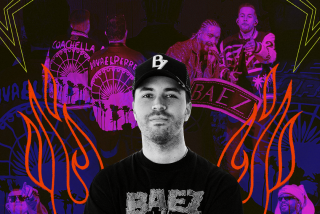APPRECIATION : Lee Brevard Was a Jewel of a Guy in Fashion
- Share via
When jewelry designer Lee Brevard walked into his Venice studio a few weeks ago, a bit fatigued from nonstop traveling to show off his wares, he found a summons from Heather Locklear for a jewelry fitting and a phone message from Elizabeth Taylor’s minions.
He glanced at the message from Taylor, the woman whose name is synonymous with diamonds. “Yeah, she needs some jewelry,” he said matter-of-factly.
In a fickle world where the competition among style makers is fierce, Brevard had become in the past few years the jewelry designer du jour to actresses and publicists, trendy high schoolers and their sleek mothers. When he died on Sunday at age 45 at the home of a friend in Hollywood--autopsy and toxicology test results are pending--his work was ensconced in every Neiman Marcus store in the country. Brevard estimated he would do $3 million in retail sales this year.
“Now was the hottest time for him,” said Charla Krupp, entertainment editor of Glamour magazine, who had written about Brevard and become his friend.
At a time when everyone was buying chunky earrings--”Bulgari knockoffs” he called them--Brevard scaled down the size of jewelry, eschewed glitzy flash and pioneered the tiny earring movement.
Each earring, crafted of either 18-karat gold or silver, sometimes set with small precious or semiprecious stones, was a collection of little movable parts. Nothing was ever soldered stiffly together.
He attributed that fluidity of design to his art school background, particularly his experience with sculpture. “I think I have that advantage over other designers,” he said. “I’m not struggling so much with balance and form and color because I had that in my training.”
For the last four years, his tiny pearls, crosses and oddly named handmade designs--he called one abstract form a “hummingbird”--dangled from gold hoops in the lobes of fashionable women. His bead and pearl necklaces draped their torsos.
Although not awe-struck by his celebrity clientele, Brevard seemed to take delight in their attention. He kept carefully tended albums of press clippings bursting with photos of Susan Sarandon and Julia Roberts in earfuls of his jewels. Farrah Fawcett wore his work on the cover of Vanity Fair, Jodie Foster on the cover of Redbook and Rob Lowe on the cover of People. Coming soon: Candice Bergen wearing a necklace of his pearls in a TV commercial.
Laura Leighton, the villainous Sydney on “Melrose Place,” borrowed Brevard jewelry for a big bash and later bought some of it. “I fell in love with the ring and it fits me perfectly so I’m afraid I must have it!” she wrote in a note to the designer.
“It’s not ostentatious,” Brevard said of his jewelry in an interview two weeks before his death. “That’s a very important thing for me--that it be complementary to the person rather than outshining the person. It’s not the kind of jewelry in which you’re showing off how many dollars you have.”
But it helps to have a lot. Each earring is sold separately, with the least expensive tiny silver heart costing about $40. His necklaces and bracelets cost hundreds or thousands.
Brevard made no apologies for his prices. “It’s not expensive if you think that it’s very exclusive. You can’t find it in every shop, you can’t find it on every street corner.”
The designer gave some celebrities a price break, offering a 40% discount to those photographed in his work. But anyone who acted as though they were entitled to a discount was met with disdain. “The more pushy and obnoxious they get, the less they get,” he said, chuckling, in his studio, his parrot, Bucky, in a cage nearby. “I let them think they’re getting something, but they’re not. I kind of reward good behavior with a good discount.”
The man responsible for little earrings was a barrel-chested 6-foot-4, with massive hands and thick fingers. On one, he wore a thick gold ring set with an emerald, his own design. Otherwise, he wore little jewelry, though he coveted a Barry Kieselstein Cord ring and recently visited it at Neiman Marcus. “It just would be nice to have something that’s not mine,” he said wistfully.
Brevard studied art at Arizona State University and Cooper Union in New York before a French diplomat became his patron and whisked him off to Paris. He painted and lived, by his own description, a “decadent” lifestyle. He eventually tired of Europe, though, and made his way to Los Angeles, where he struggled to sell his abstract watercolors.
A whim to put real emeralds into a painting sparked his first foray to the jewelry market. Fascinated by stones, he sold them loose for a while before beginning to make jewelry in the mid-’80s. Fashion stylists and costume designers helped push his work when few people knew who he was.
Although he talked of showing his paintings, he considered himself a jewelry designer. “I think the most exciting thing for me was the selling of the jewelry,” he mused. “If you said emerald, you didn’t have to explain much. If you said painting, you had to explain your whole life and the reason you were worth anything and the reason they should come to your studio--other than maybe they could get you in bed or think that they could.”
Among his cult of followers were early fans, with whom he was generous with gifts and occasional markdowns. He also painstakingly crafted custom designs for friends.
Eight days before his death, he presided over a trunk show at Neiman Marcus. Pam Sonnenblick, 35, who had met Brevard several months earlier, hovered over a $3,175 blue, black and white pearl necklace. She put a manicured hand on his. “What do you think? Do you want me to have it?” she asked. He nodded, marking down the price to $2,975. She bought it.
“He really started 24-hour-a-day jewelry, to wear to the gym, the office, everywhere,” said Jennifer Kaufman, who carried Brevard’s designs in her Beverly Center store. “There really is no such thing as dress-up jewelry anymore.”







